www.idosr.org Kizito
©IDOSR Publication
International Digital Organization for Scientific Research
IDOSR JOURNAL OF SCIENCE AND TECHNOLOGY 9(1):1 -26, 2023
ISSN: 2579-079X
An SMS-Based Examination Relaying System: A Case Study of Kampala International University Main Campus.
Kizito Bernard WamalaDepartment of Information Technology, Kampala
ABSTRACT
International University, Uganda.The implementation of mobile technologies makes it possible for us to have mobile information application. With this information can be delivered and accessed via various types of portable devices immediately. Mobile information provides mobile users with versatile communication to other people and expedient notification of important events, yet with much flexibility, portability and mobility. It also permits mobile users to have access to information regardless of their physical locations. Looking to the flexibility, portability and mobility offered by mobile technologies, here in this paper we will come out with one of mobile information application called SMS based exam result relaying system. This system will enable students to have access to their exam result via mobile phones. A successful system is a system that can fulfill user satisfaction and can be accepted by the users. Usability is one of the important factors in determining user acceptance toward a new system. In order to find out the usability of the system we conducted a usability testing and distributing questionnaire. The questionnaire is based on the four usability factors such as effectiveness, learnability, flexibility and attitude to determine students’ view on the SMS based exam result relaying system. The result of this study showed that the overall level of the usability for four construct (effectiveness, learnability, flexibility and attitude) in student’s pointof view is in the acceptable level.
Keywords: Usability, Mobile technologies, SMS-based, Mobile information.
INTRODUCTION
From accessing course materials to retrieving exam result information, all could be done ubiquitously. A study by [1; 2; 3; 4; 5; 6] showed that 62 percent of students were in favor of getting their grades sent directly to their mobile phone, rather than having to rely on the postman to ensure they are delivered on time. The previous methods used in delivering students’ exam result could be improved by applying mobile technology into it. Hence comes the introduction of mobileresult – an application of delivering students’ exam information in mobile computing environment [7; 8; 9; 10]. Besides that, the implementation of this prototype offered students with more alternative medium in getting their result information [4; 5; 11; 12; 13]
Short Message Service (SMS) is a text messaging service component of the phone, web, or mobile communications
systems using standardized communication protocols that allow the exchange of short text messages between fixed line or mobile phone devices [6; 7; 8; 14; 15; 16; 17].
SMS as used on modem handsets was originated from radio telegraphy in radio memo pagers using standardized phone protocols and later defined as part of the Global System for Mobile Communications (GSM) series standards in 1985 as a means of sending messages of up to 160 characters to and from GSM mobile handsets [9; 10; 18; 19; 20]. Since then, support for the service has expanded to include other mobile technologies such as ANSI CDMA networks and Digital AMPS, as well as satellite and landline networks [11; 12; 21; 22; 23]. Most SMS messages are mobile tomobile text messagesthoughthe standard supports other types of broadcast messaging as well [13]. SMS
Based Examination Results Relaying System is an SMS - based system that will enable campus students to receive their results on their mobile handsets by simply sendingspecificinformation tothesystem [14]. Development tools for this system will include a personal computer running on a windows operating system, a GSM modem, an SMS enabled phone, an SMS engine software, and a system application developed using Java software.
Statement of the Problem
Due to the increased cost of living such as increased transport costs among others, there is a growing need to bring services closer to people. Such services may include information. Thus given the situation where students have to individually pick and view their results, it is instead easy and cheaper for them to view their results via mobile phone using SMS technology compared to physically picking and viewing them. Thus Short Messaging Service can be used to bring exam results information closer to the people.
Aim of the Study
The aim of the study was to enable students receive and view their examination results via mobile phones using SMS technology.
Specific objectives
To design, develop, and implement and examination results relaying system interface and databases.
To configure a GSM modem to enable sending messages to and from the examination results relaying system
To ensure privacy while viewing individual examination results.
To bring about flexibility in receiving and viewing examination results from any location.
To reduce on crowds at faculty offices while picking and viewing results.
Research Questions
How flexible is it for students to receive and view their results?
How does the current system ensureprivacyforstudentsviewing their results?
How is crowding at faculty offices while students are receiving and viewing their results handled?
How will the system interface and database be designed?
How will results be sent to students?
Significance of the Study
Present and future scenarios of the learning process claim students to be mobile. The availability of this mobile application could support students’ mobility. The introduction of this application could fulfill students’ mobility because it enables students to retrieve their exam result via their mobile devices. Flexibility is one of the features of this application. This feature enables students to apply this application anytime and anywhere they want. Furthermore, the architecture of the system provides realtime feedback, means that student can get exam result immediately. Besides that, the implementation of this service will offer students with various alternatives in receiving and viewing their result information. Besides relying on the PC or paper, queuing up at faculty offices or relying on notice boards for students to view there results, now students can get their result information through mobile devices. The system will also benefit student in the way of its deployment because it does not require any special software to be installed in student mobile phone.
This project also has significant value for the lecturers. For the lecturers this service will reduce their workload in managing student results. In this application results will be stored in a database and it is easy for the lecturers to update any changes. In addition,throughthisapplicationstudents requestwillbeautomaticallyservedbythe system. This system requires less monitoring by system administrator.
METHODOLOGY Scope of the Study
The study was carried out at Kampala International University main campus
under the College of Applied Sciences and Technology. This project took about six months to be completed. The first three
www.idosr.org
months were used for data collection and analysis. The following three months were used to design the actual system that was then implemented and tested to see if it met the set objectives. The respondents in this study were students from the College of Applied Sciences and technology. SMS technology was be used in developing the systemandGSM technologywasapplied.A mobile phone with the ability to send and receive messages was used to test the new system.Testingtheusabilityofthesystem wasbasedon four usabilityfactorsnamely effectiveness, learnability, flexibility and attitude.
Data Collection
Data collection refers to techniques that are used to collect data. Below are some methods of data collection that were used: interview, questionnairesandobservation. Project planning and feasibility study. Planning establishes a high level view of the intended project and determines its goals, it involves planning for the following;
User requirements
User requirements are requirements that are not full filled by the current system hence not satisfying the needs of the current user of the system. In our case there is a need for users of the current system to acquire their results fast, a need which is not fulfilled by the current system.
Hardware requirements
The hardware that will be used in this projectwillinvolve computers thatwillact as servers to run the developed system, a GSM modem that will be useful in the forwarding of sent and received messages to and fro the system and finally a mobile phone that will provide the interface for writing, reading, sending and receiving messages.
Software requirements
Kizito
The software requirements that will be used in this project are Java software that will be used to develop the system interface, My SQL server software will be used to develop the system database that will store student information and Now SMS software that will act as a middleman tothemodemandthesystemontheserver computer.
System Analysis. Designing the system
The system will be designed using a windows based personal computer. A GSM modem will be used to enable the sending and receiving of messages. Java software and Java programming language will be used in designing the application/system interface and MySQL be used to design the application databases. Ozeki SMS software will be used and a middle ware to manage the interfacing of the GSM modem and system applications.
Usability testing
The system will be tested by the user to check if the user requirements are tested. If the user sendsa valid request SMS to the system, he should get three things;
A reply SMS
Correct examination results
Readable examination results
If he sends an invalid request SMS to the system, the system should respond with a proper failure SMS message.
Implementation and maintenance
The implementation of the system will be donein thecollegeofappliedsciencesand technology after it has been tested. This process will follow parallel implementation method where the new system will be implemented alongside the current system. The system will be maintained by a system administrator for the college.
RESULTS
Demographic characteristics of the sample
The demographic characteristic of the sample is characterized in the table below
and is based on the eight questions from the questionnaire. All the questionnaires were responded to so in total there were 200 respondents
Demographic characteristic of the respondents
QUESTION ONE
Table 1: Showing sample population to be either satisfying or dissatisfying
How do you find the current system of receiving results?
How do you find the current system of receiving results?
How do you find the current system of receiving results?
Accordingtothetableandthegraphabove 25% of the sample population found the current system very satisfying. Literary that is a quarter of the sample population. 15% of the sample population found the system satisfying, 50% the sample
population found the system least satisfyingand10%ofthepopulationfound the system dissatisfying. So half of the population did not approve ofthecurrentsystemandwouldliketosee new improvements made to it.
QUESTION TWO
Table 2: How easy is it for you to receive your results using the current system?
How easy is it for you to receive your results using the current system?
How easy is it for you to receive your results using the current system?
Fig 2: How easy is it for you to receive your results using the current system?
In this question we found out that 10% of the sample population found it easy to receive their results and 15% found it very easy but on the hand 50% of the sample population found it difficult to find there results and 25% of this very population found it very difficult.
So a big number of the students found some sort of difficulty when receiving there results which implies that improvements on the current system have to be made to tackle student issues.
QUESTION THREE:
Table 3: How do you acquire your results?
How do you prefer to acquire your results?
How do you prefer to acquire your results?
Fig 3: How do you prefer to acquire your results?
When asked how they would prefer to acquire there results, majority preferred SMS. 10% of the population preferred email, notice boards and head of department while 25% preferred to receive their results through a university website.
Therefore if the current system was to be improved, the use of SMS and university websitetoacquireresultswouldhavetobe taken into consideration.
QUESTION FOUR: Table 4: What would you prefer to do first?
What would you prefer to do
first?
What would you prefer to do first?
Fig 4: What would you prefer to do first?
www.idosr.org
When asked the above question, majority preferred to have a glance of their results
before they could actually have a glance at their actual results slip.
QUESTION FIVE: Table 5:
1. What is required of you in order to acquire your results?
What is required of you in order to acquire your results?
What is required of you in order to acquire your results?
Fig 5: what is required of you in order to acquire your results?
QUESTION SIX: Table 6: Which Mobile network do you often use?
Which Mobile network do you often use?
Which Mobile network do you often use?
Fig 6: which mobile network do you often use?
QUESTION SEVEN: Table 7: What better ways would you prefer to use to receive your results and why?
What better ways would you prefer to use to receive
your results and why?
What better ways would you prefer to use to receive your results and why?
Email SMS Campus website Notice board
Fig 7: what better ways would you prefer to use to receive your results and why?
www.idosr.org
QUESTION EIGHT: Table 8: Is there a possibility for some else to acquire someone else’s results?
Is there a possibility for some else to acquire some one else’s results?
Is there a possibility for some else to acquire some one else’s results?
Fig 8: Is there a possibility for some else to acquire someone else’s results?
www.idosr.org
SYSTEM DESIGN AND IMPLEMENTATION
Conceptual Model of the new working system.
FACULTY ADMINISTRATOR GSM MODEM
SMS BASED EXAMINATION RESULTS RELAYING SYSTEM
SMS GATEWAY USER PHONE
Physical Design
The physical design involved the creation of database tables to capture data entered into the new system.
The table layout of related elements looked as shown below;
System Testing
Here program modules are to be tested to eliminate any errors that may exist. The new system is also tested to check if it’s compatiblewiththehardwareit’sintended to run on. The testing process can be viewedaspart of the trainingexercise as it also involves users for familiarity and accreditation.
The modules were tested by using them to collect and enter data into the data. Student personal information, course unit information and results of one student were collected and inserted into the database. An SMS server called OZEKI SMS was interfaced with the system database and programmed to retrieve data from the database based a given keyword.A modem was installed and configured to work with the SMS software. Once an SMS containing a keyword such as a registration number was sent, it was received by the SMS software installed on the PC and the content of the SMS were compared with those in the results database and once a match was found the results associated with the keyword were retrieved, converted into andSMS andthen sent back to the recipient.
System Implementation
SMS Send Method
The user ofa mobile phone will have a text containing a keyword to the system. This keyword will be no longer than 160 characters. These characters can be text (alphanumeric or binary Non-Text Short messages).
SMS Process Method
Once the SMS message is received by the SMS sever on the client computer, it’s stored in a central short message center. Since the message contains a keyword, the keyword willbe processedbycomparingit with the one in the results database. If it matches, the results associated with the keyword willberetrievedandifitdoesnot match with any key word in the database, then no keyword will be retrieved.
SMS Reply Method.
The retrieved results will then be converted in to a text of no more than 160 characters and will be sent to sent to the recipient using the same mobile phone number. If the text is more than 160 characters the recipient should expect two or more SMS messages. And if the recipient’s number is not available, then the message will be stored in the short message center and sent letter.
Flow of the system
Fig
A DSL modem is to be connected to the PC. Since its external it is connected using special networking cables and the process of setting is shown below;
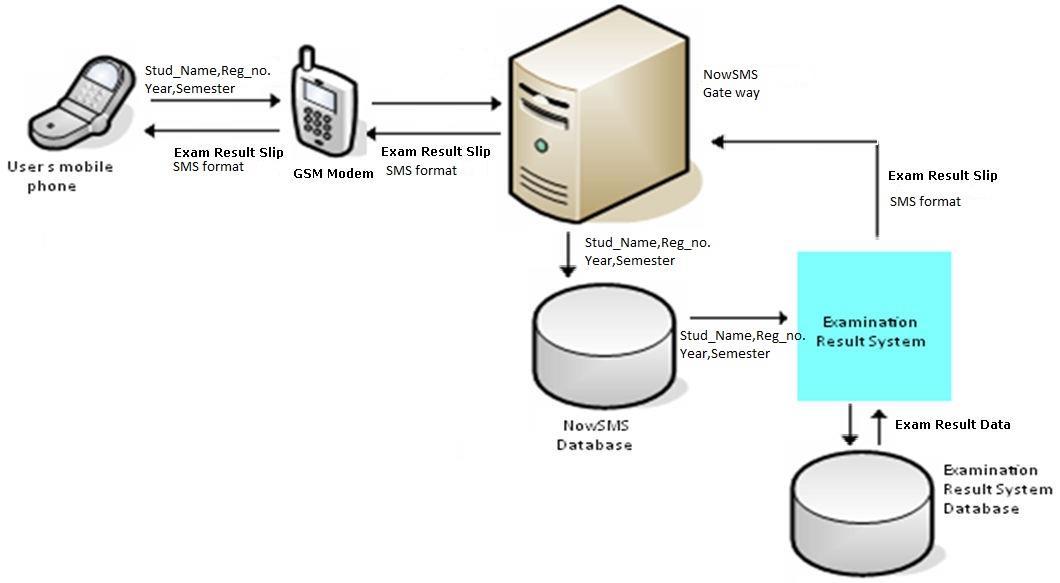
Power off both the computer and the modem
Connect the Ethernet cable to the modem
Plug the other end of the cable into the computer
With the modem and computer connected by the Ethernet cable, turn on both the modem and the computer. Boot the computer and configureInternetaccess.Allowthe computer to fully boot up, then configure the machine's Internet access using the instructions provided by your DSL service provider
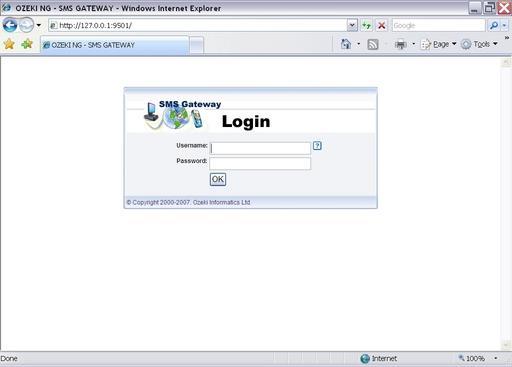
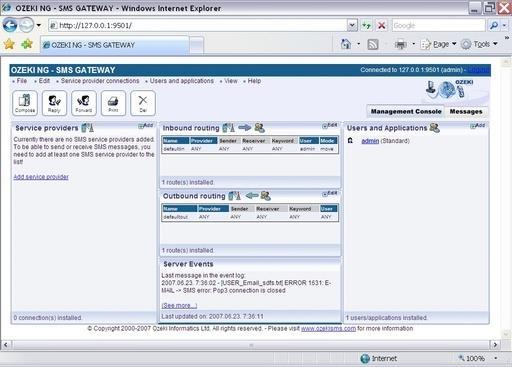

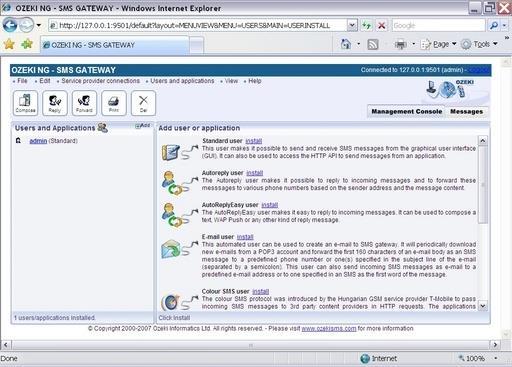
SMS Exam Results System (Client side)
When the system is run three a login form will appear to prompt user to enter Password. If the password is not valid a message will appear saying invalid
username and password and if it is valid a tabbed form containing all the three forms willappear.Theabovesaidforms willlook like as show below.
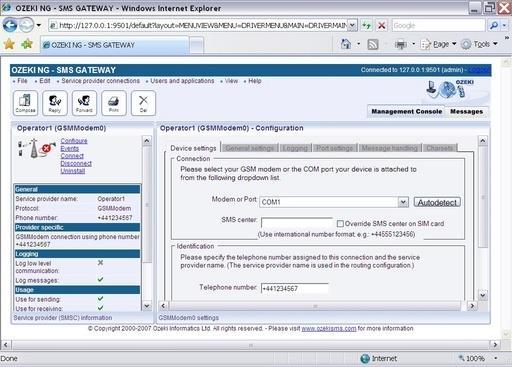
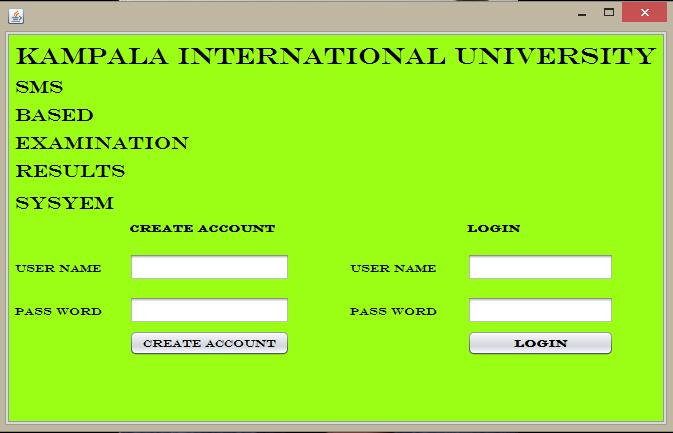

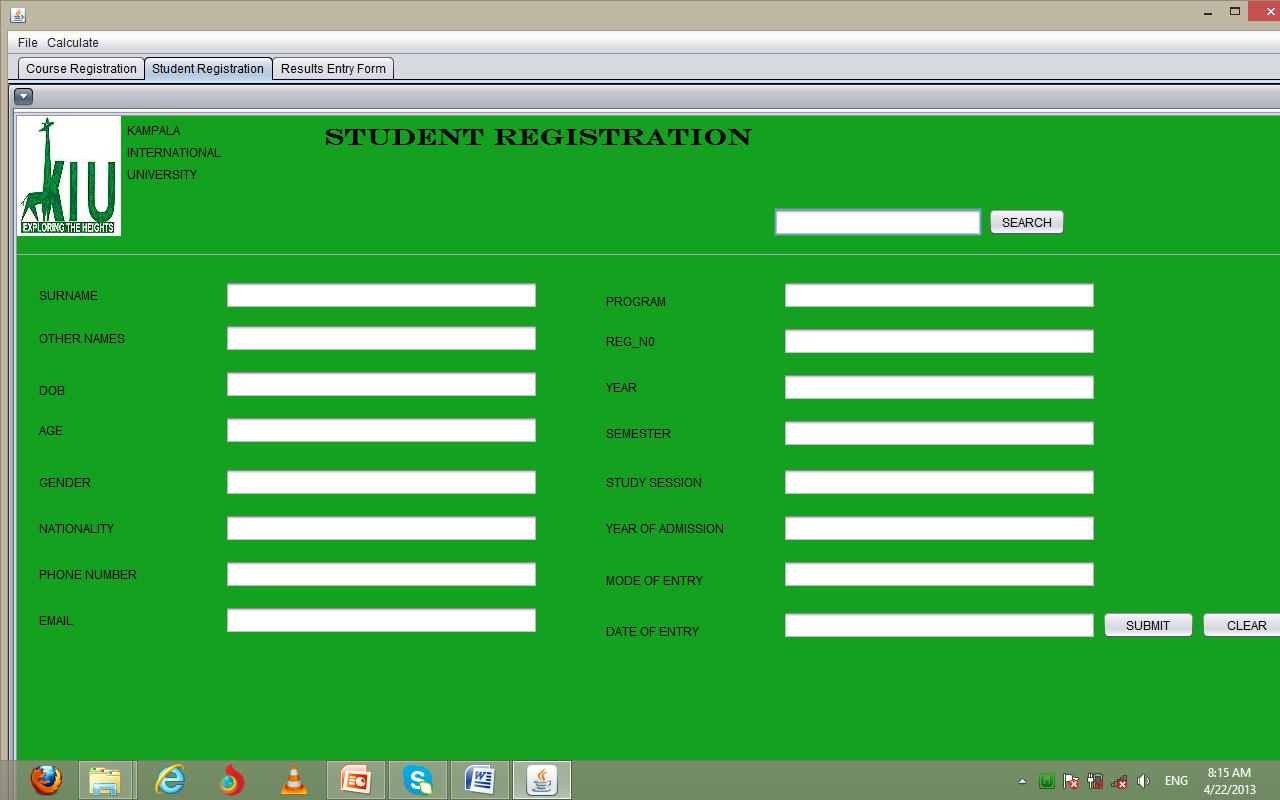
Fig 19: Results Entry Form
Database Installation
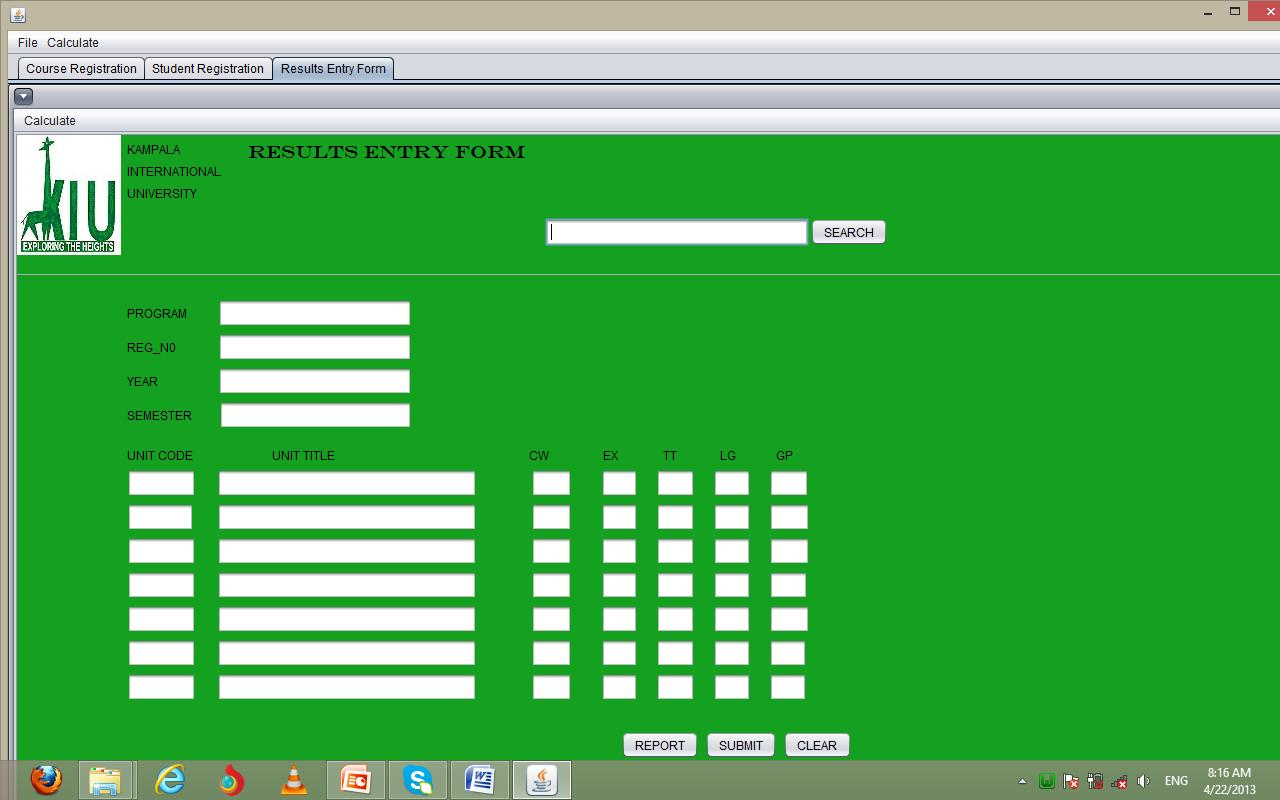
The system will use a My SQL database to run and store data collected using the above forms. My SQL is free open source database software that can be downloaded from the internet for free. This will interface with the modules using java code.
A My SQL Connector/ODBC 5.1 was installed and used by the java application to communicate with My SQL database.
Compiling Packaging
Fortheapplicationtorunindependentlyof the java IDE, it’s compiled and stored in a distribution folder. It’s this folder that is moved from one machine to another. The application is run from inside the folder and a My SQL database has to be running before the application is started. For the application to run more efficiently on any machine, a java development kit has to be installed first.
DISCUSSION
The Effectiveness of the SMS Exam Results Relaying System.
With the rising adoption of mobile phone with 3G and wireless connections among students, it’s not surprising that students prefer to use their mobile devices as messagingtoolsso theeffectivenessofthe SMS system is high because it’s easy for students to simply send and SMS. Also the use of SMS is to some extent cost effective as mobile subscription plans come with free SMS bundles thus no additional cost of sending SMS Studentswanttosee theirresultsfastonce they are notified that they are out. So the systembecomeseffectiveoncethestudent sends an SMS to the system and immediately receives an SMS containing the requested results.
The fact that the system provides a response automatically makes the whole setupeffective.Whenastudentqueriesthe
With the current trend of using SMS to communicate and ease of using SMS technology to communicate, the student
systemforresults thestudents receivesan automatic reply because the system is automated.
Learnability of the SMS Exam Results
Relaying System
The system will be specifically used to receive results once they are available by simply querying the system using a keyword.
The system interfaces are easy to learn with exception of the SMS interface which with a little training will be adapted to.
Flexibility of the SMS Exam Results
Relaying System
Since no special training is required to teach students on how to send results, it becomes practically easy for students to send SMS and receive results from anywhere at any given time. Plus it is also easily accessible any time and from anywhere which makes it flexible
CONCLUSION
attitude toward using SMS exam results relaying system is positive with no bias.
RECOMMENDATION
For effective performance of this system and continuous development of the system we advocate that University should;
Invest in more research/study be done on the study area to determine the rate of growth of the university to enable better data validation refinement,
Insist on more logical security concern to be undertaken to open doors for internet database connectionaswiththeexistingdata storage capabilities in the internet
the university will save even further in data storage,
Continuously encourage system usage by observing the use of the system, conducting user satisfaction surveys and meetings, providing additional training, and logging enhancement ideas,
Invest in better backing up techniques and data recovery software’s for reduce system down time and increase its durability and reliability.
REFERENCES
1. Chen, J., Linn, B and Subramanian, L. SMS-based Contextual Web Search”, Proc.1
2. Houser, C. and Thornton, P. (2005). Poodle: a course-management system for mobile phones. Proc. 2005 IEEE Workshop on Wireless and mobile Technologies in Education, Tokushima, Japan, 5pp.
3. Ching, L T. and Gang, H K “Designing SMS Applications for transport service system in Singapore” Proc. 8
4. Ambler, S. W. (2012). The Agile System Development Life Cycle (SDLC).http://www.ambysoft.com/ essays/agileLifecycle.html#Fingure DetailedLifecycle. Accessed on 2 Oct, 2012.
5. Ismail, M. N. (2009). Development of WAP Based students Information System in campus environment. International Journey of computer theoryandengineering, vol.1, no.3, pp260-271.
6. Khamis, N. and Aug, G. W. (2005). The Student Information System using WAP Technology. Malaysian Online Institution of Instructional Technology, vol.2, no.1
7. Arteaga, A. S., Kudeki, M. and Woodworth, A. (2009). Combating Obesity Trends in Teenagers through persuasive mobile technology”, Sigaccess newsletter, issue 94, pp17-24
8. Atkins, A K., Ali, H. N. and Shah, H. “Extending E-Business applications using Mobile Technology”, Proc of 3.
9. Malaysian Communications and Multimedia Commission, “Cellular Phone Subscribers”, http://www.skmm.gov.my/factsfigures/stats/index.asp. Accessed on 2 Feb, 2012
10.Kothari, G., Negi, S., Tanveer, F. A., Faruquie, T. A. Chakaravarthy, V. T. and Subramanian, L. V. (2009). SMS based Interface for FAQ Retrieval, Proc of the joint Conference of the 47th Annual Meeting of the ACL and the 4th International Joint Conference on Natural Language Processing of the AFNLP, vol.2, pp. 852-860.
11.Marshall,F.F.,Mu'azu, M.B.,Umoh, I. J., Salawudeen, A. T., Sadiq, B. O. and Ikpe, D. E. (2019). A modified real-time fault-tolerant task allocation scheme for wireless sensor networks. Kinetik: Game Technology, Information System, Computer Network, Computing, Electronics,andControl, 45-54.
12.Garba, S., Yahaya, B., Sadiq, B. O., Udekwe, D. A. and Abubakar, Z. M. (2019, October). Implementation of Timing and Synchronization in Digital Clocks: A Wireless Communication Design. In 2019 2ndInternationalConferenceofthe
IEEENigeriaComputerChapter (pp. 1-4). IEEE.
13.Adabara, I., Enerst, E , Ginabel, O., Okoth, O., Stephen, K S (2019). Implementation and Analysis of a Free Wireless Intercom System. International Journal of Academic Information Systems Research (IJAISR), Volume 3, Issue 7, Pages 23-28.
14.Fashoto, S. G., Ogunleye, G. O. and Adabara, I. (2018). Evaluation of Network and Systems Security Using Penetration Testing in a Simulation Environment. Computer Sciences and Telecommunications, (2), 91-99.
15.Mundu,MMSNNnamchi,KJUkagwu (2020) Algorithmized modelling, simulation and validation of clearness index in four regions of Uganda. Journal of Solar Energy Research 5 (2), 432-452
16.Jean-Rostand FK, MM Mustapha, I Adabara, AS Hassan (2019).Design of an automatic transfer switch for households solar PV system European Journal of Advances in Engineering and Technology 6 (2), 54-65
17.Nnamchi S. N., O. A. Nnamchi, EO Sangotayo, MM Mundu, OO Edosa Designandfabricationofinsulation testing rig. Indian Journal of Engineering 16, 60-79
18.Nnamchi SN, MM Mundu, OA
Nnamchi, U Onochie, ZO Jagun (2022) Differential modelling and simulationofsolarpowerpotential: a helio-application of biharmonic model Modeling Earth Systems and Environment 8 (2), 2383-2400.
19.MM Mundu, SN Nnamchi, OA Nnamchi (2021). Development of a model for estimation of sunshine hour data for different regions of Uganda Journal of Renewable Energy and Environment 8 (1), 6976
www.idosr.org
20.Monyjok EM, MT Mayen, M Lawrence (2023)
21.Responsive Real-time Information System for Managing Patient’s Medical Records: A Case Study of Juba Teaching Hospital. IDOSR
Journal of Computer and Applied Sciences 8 (1), 1-8.
22.Namugenyi MS, F Abdalla (2022) An Automated Student Registration System: A Case Study of Lugazi Primary School INOSR
ExperimentalSciences 10 (1), 25-41
23.Nambale A, Z Kalyankolo, U Kalyankolo. Design and Implementation of an Intelligent Voice Controlled Wheel Chair
IDOSR Journal of Science and Technology 7 (1), 67-76
